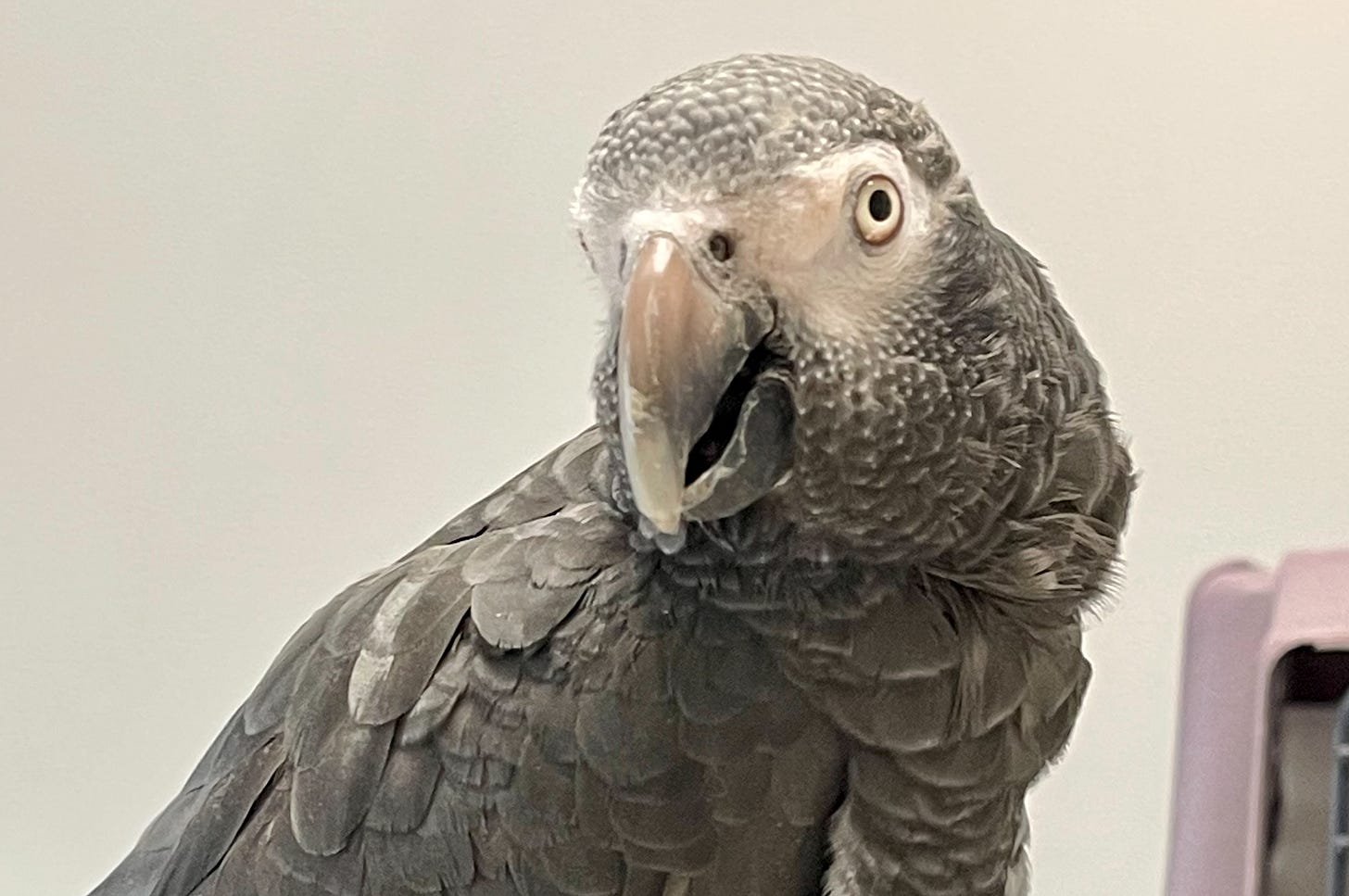This has happened to me a lot.
Every time it happens, I’m a mix of emotions: a little sad, strangely happy, anxious, and filled with peace. It’s complicated, but it’s real.
When animals come to see me, something happens. Sometimes the connection is brief and superficial—like passing someone in the grocery store aisle and exchanging a smile or a hello. But other times, it's deep. Sometimes they look into me, into my soul, and ask me to do something impossible. To fix it. To stop the pain. To make it better.
Yesterday, an African Grey named Alex came to my hospital. My team rushed him in—he could barely breathe. He was leaning against the side of the carrier, head down, beak open, panting like a Labrador after chasing a ball 100 times. But this wasn’t play. This was panic.
I scooped him up. He didn’t fight. That’s when I knew we were in trouble.
I placed him in oxygen. He allowed every touch. Every movement. He was too weak to flap, too tired to resist. He looked straight into my eyes as if to say, "Do you have any idea how hard it is to breathe?"
Actually, I do.
When I was eight, I spent the summer at my grandparents’ campground. It was heaven—woods, lakes, fishing, and a raft out in the middle of the water where we kids jumped off all day long. One day, I jumped from that raft and my foot got caught in the rope that ran around it. I was stuck, upside down in the water. I flailed. I swallowed water. I panicked. I couldn’t breathe.
Other kids tried to pull me up. I remember someone grabbing my waist, yanking me up, and pounding my back. I vomited and finally gasped a little air. The pain in my chest was like fire—but I could breathe. That moment changed me.
And in the hospital yesterday, looking at Alex, I saw myself in that moment.
I told him: "Not on my watch, Alex. Stay with me."
We got to work.
I suspected congestive heart failure—common in African Greys, especially those on seed-heavy diets. I could hear the crackles in his lungs, feel his heartbeat like a hummingbird under my fingers.
I pulled up the meds: Lasix to pull the fluid out of his lungs, and Torbugesic to relax him and ease the stress of drowning in his own body. One of my technicians gently held an oxygen tube to his beak, and he responded immediately, locking onto the oxygen like it was life itself. If she moved, he moved with it.
We watched his breathing rate go from 102 to 68 respirations per minute in 30 minutes. Then it was 38 respirations per minute. His head lifted. His eyes softened. The panic was slowly leaving his body.
He was breathing. Deeply and rhythmically he drew in the air and exhaled with ease.
Another hour later, his respiration rate was 32. We weaned him off oxygen and watched him stabilize. By the time his family returned, Alex was upright in his carrier, calm, alert, and alive.
But here’s the truth:
Congestive heart failure isn’t something you cure. It’s something you manage. And it’s scary—whether you’re a bird, dog, cat, or person. It means the heart has been overworked for so long that it’s failing to keep up. You can stabilize. You can improve. But you’re never really “out of the woods.”
Alex will be on medication for the rest of his life. How long is that? I don’t know. Two weeks? Two years? No veterinarian has a crystal ball. But I do know this:
His family will be more mindful. His diet will change. And hopefully his story will help someone else understand that seed-only diets are a silent killer in parrots. They’re too fatty. They lack the nutrients a bird’s heart and vessels need to function. We see the consequences—arteriosclerosis, heart disease, shortness of breath, early death.
But it doesn’t have to be this way.
Pellets. Fresh fruits and vegetables. Legumes. A touch of seed. That’s the balance. That’s the breath.
Alex gave me a gift yesterday. He reminded me why I do this. Why I show up every day. Why I fight for every breath an animal takes.
And why I never, ever take mine for granted.
Grateful for each day I can draw a deep breath without struggle. Grateful for each day I can offer that same gift to another being—feathered, furry, or scaled. The emotions that come with this work are raw, tangled, and sometimes overwhelming, but they are real. And they remind me, every single day, that life is fragile, breath is sacred, and presence is everything.






